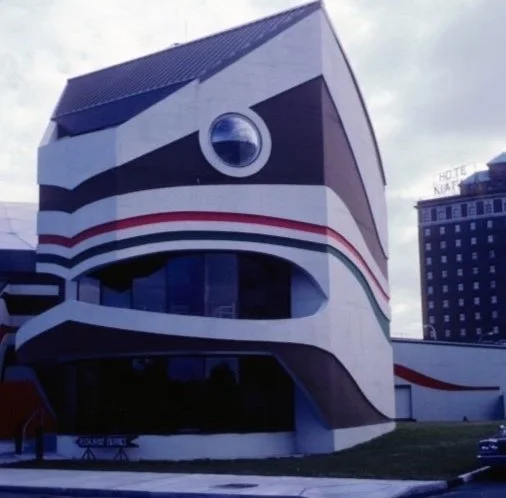The Turtle of Niagara Falls: A Sacred Symbol, a Cultural Treasure, and a Building Worth Saving
Image of the building from 1981, when it was still brightly colored.
The Turtle of Niagara Falls: A Sacred Symbol, a Cultural Treasure, and a Building Worth Saving
The Turtle — officially called the Native American Center for the Living Arts — is one of the most unique and meaningful buildings in Niagara Falls, New York. Completed in 1981 and designed by Arapaho architect Dennis Sun Rhodes, the structure was built in the shape of a giant turtle, using a modern Indigenous architectural style that combined traditional symbolism with contemporary form. The building’s design draws directly from the Haudenosaunee creation story, where the Earth — known as Turtle Island — forms on the back of a turtle after Sky Woman falls from the sky.
The Turtle is a rare and powerful example of Indigenous Modernist architecture, blending Haudenosaunee spiritual symbolism with the concrete-driven, expressive forms of mid-century Brutalism. It’s both a literal and cultural monument — shaped like the Earth-bearing turtle of creation stories, and constructed in a time when Native architects were reclaiming the built environment as a space for storytelling and resilience.
For years, The Turtle was a vibrant hub for Native American art, performance, and storytelling. It hosted exhibitions, concerts, dance performances, and educational events that celebrated Indigenous culture, history, and language. At its peak, it was one of the largest Indigenous arts centers in the Eastern United States.
But in 1995, The Turtle closed due to financial difficulties. Since then, it has remained empty. Its once-vivid turtle-shell exterior has been painted over, and many locals and visitors now walk past without knowing the powerful story it represents.
Today, there’s hope for revival. A group called Friends of the Niagara Turtle, made up of over 1,000 Indigenous and non-Indigenous supporters, is working hard to bring The Turtle back to life. They’ve been collaborating with Haudenosaunee leaders and artists to reopen the space as a living cultural center once again—one that honors both tradition and future generations.
In 2025, The Turtle was named one of America’s 11 Most Endangered Historic Places by the National Trust for Historic Preservation. This national recognition has helped raise awareness about its cultural importance and the urgent need to preserve it.
But the Turtle isn’t just about architecture or history. It’s about something deeper.
In Haudenosaunee tradition, especially among the Seneca people, the turtle is a sacred symbol of creation, endurance, and balance. In their creation story, Sky Woman was saved by animals and placed on the back of a giant turtle, which grew into the land we live on — Turtle Island. The turtle represents the Earth itself: strong, steady, and sacred.
This ancient story even inspired Stephen King, who reimagined the turtle in his Dark Tower series. There, King introduces Maturin, a wise and benevolent turtle who “vomited the universe” and serves as a cosmic guardian of balance. While fictionalized, King’s version draws from real Indigenous teachings — teachings that see the turtle not as fantasy, but as a living part of spiritual reality.
Why It Matters
The Turtle in Niagara Falls is more than just a building. It’s a reflection of Indigenous wisdom, art, and spiritual resilience. Saving it means honoring the stories that shaped this land — and ensuring they continue to be heard.
🎥 Want to see more about it?
Check out this short video on the efforts to save The Turtle:
Watch this short video on the effort to save The Turtle by clicking here.


